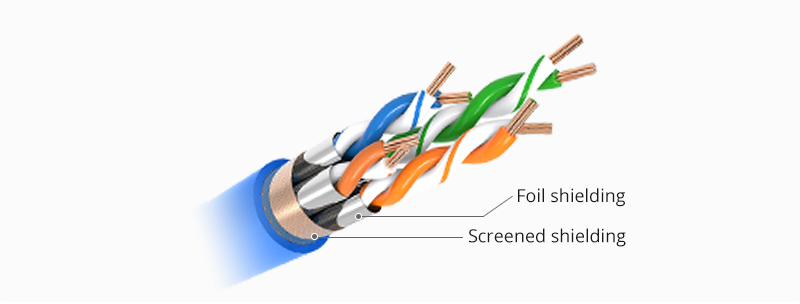For additional noise immunity, twisted pair cabling may be shielded. Cable with shielding is known as shielded twisted pair (or STP cable) and without as unshielded twisted pair (or UTP cable). Below content explains their differences in detail.
Unshielded Twisted Pair Cable
UTP cable is low-cost network cable built with a pair of insulated conductors twisted together and covered with a plastic jacket for protection. It has no foil wrap shielding or braided shielding screen, which makes the cable smaller in diameter. 24 AWG (short for American Wire Gauge) is the most commonly seen size of UTP cables. Thinner UTP cables are easy for routing through the tightest spaces and cable management panels, which further helps improve the air-flow and reduce the risk of network down-time.

Applications of UTP Cable
Except for its use in many Ethernet networks and telephone systems. UTP is also the most common cable used in computer networking. And as UTP cable bandwidth has improved to match the baseband of television signals, UTP is now used in some video applications as well, primarily in security cameras.
Benefits of UTP Cable
- It is less expensive and less costly compare to other networking media types.
- It is the most compatible cabling and can be used with most other major networking systems and does not require grounding.
- It is smaller in size; hence installation is easier as it does not fill up wiring ducts.
Shielded Twisted Pair Cable
Similar to UTP cable, STP cable contains an extra foil wrapping or copper braid jacket to help shield the cable signals from interference, thereby transporting data faster. STP cables work by attracting interference to the shield, then running it off into a grounded cable. According to different shieldings, STP cables can be divided into several types:
Foil Twisted Pair (FTP) – With FTP cables, each twisted pair of cables is wrapped in a shielding of foil to protect the cable from EMI and crosstalk.
Shielded/Foil Twisted Pair (SFTP) – A cable that is classified as shielded foil twisted pair (S/FTP) is a combination of both FTP and STP shielding. The wires inside the cable are twisted and then shielded with foil wrapping, then the 4-pair grouping of foiled wires are shielded by a wrapping of either foil or a flexible braided screening. This provides the highest level of protection against EMI and crosstalk.

Applications of STP Cable
STP cables are widely used in computer and telephone networking, including wiring Ethernet connections for computer networks, as well as commercial and residential telephone connections. Since STP cables are durable and long-lasting, with their sheilding characteristics, they can also be used in industrial settings with high amounts of electromagnetic interference, such as a factory with large electronic equipment, etc.
Benefits of STP Cable
- Shielding reduces the chance of crosstalk and provides protection from interference.
- It supports higher data signal transmission speed.
- It provides more secure data transmission.
 汉信
汉信

